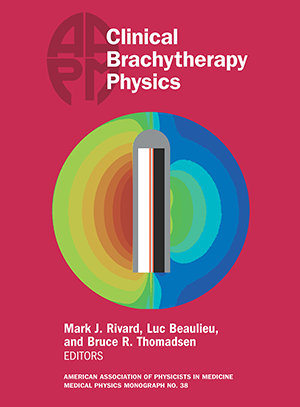
#38 Clinical Brachytherapy Physics, AAPM Monograph, 2017 Summer School
Author: Mark J. Rivard, Luc Beaulieu, and Bruce Thomadsen, EditorsISBN: 9781936366576
Published: June 2017 | 372 pp | Hardcover
Price: $ 110.00
Med. Phys. 45 (8) | August 2018
Description
This book is a faithful reflection of the proceedings from the 2017 AAPM Summer School on clinical brachytherapy physics. The three editors are internationally renowned for their expertise in brachytherapy physics and have assembled an additional 19 authors with extensive brachytherapy experience to contribute to its content. Over the course of ten chapters, this text provides a nice, concise summary of current and clinically relevant topics related to the practice of brachytherapy physics.
Purpose
As Drs. Beaulieu, Rivard, and Thomadsen state in the preface, training and education are keys to the utilization of clinical brachytherapy.With a focus on training and education, the authors have compiled a text that provides a nice summary of current and relevant brachytherapy topics, a useful and exhaustive list of references, and 10–12 questions at the end of each chapter to test the readers understanding of the material.
Audience
Based on the content of the book and the summer school attendees (76% medical physicists and 19% medical physics residents and students),1 this text is geared toward medical physicists practicing brachytherapy or those that are newly involved (e.g., early or midcareer qualified medical physicists and/ or trainees). It is a wonderful educational resource that may be used to learn about current trends in clinical practice, develop a new brachytherapy program, prepare lecture material for residents (medical and physics) and graduate students, and/or prepare for the American Board of Radiology written and oral examinations.
Content/features
Unlike the previous monogram published following the 2005 summer school, the current text is manageably sized to allow it to be read from coverto- cover as part of a course, a refresher or update, or to add or enhance one’s clinical practice. The text is divided into ten chapters focused on topics relevant to current clinical brachytherapy practice. Chapter 1 focuses on general treatment planning, reviewing radiobiological models, target definitions, implant approaches, applicator/needle localization and reconstruction, dose optimization, plan evaluation, and quality assurance. Chapter 2 provides an overview of model base dose calculation algorithms (MBDCAs), including their current commercial implementation and limitation, their impact compared to the Task Group 43 formalism, 2 and recommendations on clinical commissioning. Chapter 3 covers electronic brachytherapy (eBT), providing a description of eBT, a discussion on commercially available systems, commissioning and source calibration, dose calculations methodologies, quality assurance, and clinically relevant tips and tricks. Chapters 4–8 detail the clinical application of brachytherapy to specific treatment sites such as prostate (low-dose rate and high-dose rate), gynecologic malignancies (i.e., vaginal cuff and cervical cancer), skin, and breast. These chapters provide a rationale for the use of brachytherapy for these treatment sites, discussions on imaging and image guidance for seed and applicator placement, an overview of common applicators, planning objectives, workflow, and quality assurance. Chapter 9 presents a rationale and possible approaches to intensity-modulated brachytherapy including the use of applicators with static and dynamic shields as well as directional sources. Finally, chapter 10 covers brachytherapy technologies that are in early clinical transition, including focal therapy (e.g., for treating prostate or boosting dominant intraprostatic lesions or hemigland), 3D printing, needle tracking (i.e., using optical navigation systems, Fiber Bragg grating sensors, electromagnetic tracking, and active MRI transition), in vivo dosimetry, and robotics. Each chapter includes black and white and colored illustrations as well as tables to complement the text.
Assessment/comparison
Overall, this text is well written and provides a nice summary of current and developing clinical brachytherapy practice patterns. The one limitation to this book is its focus on the more common treatment sites. Although this has resulted in a manageably sized book, it will require the use of other references if it is intended for educational purposes to cover topics such as head and neck, gastrointestinal, thoracic, ocular malignancies, and intravascular brachytherapy. However, from my perspective as a practicing brachytherapy physicist and educator, this text will make an extremely useful reference and will certainly be added to my list of required reading for residents and graduate students.
Reviewed by Joann I. Prisciandaro, Ph.D.
Joann I. Prisciandaro is a Clinical Associate Professor and the Director of Brachytherapy Physics at Michigan Medicine, University of Michigan. She is active with the AAPM and the Medical Physics Residency program at her institution.
Med. Phys. 45 (8), August 2018
0094-2405/2018/45(8)/4003/2


